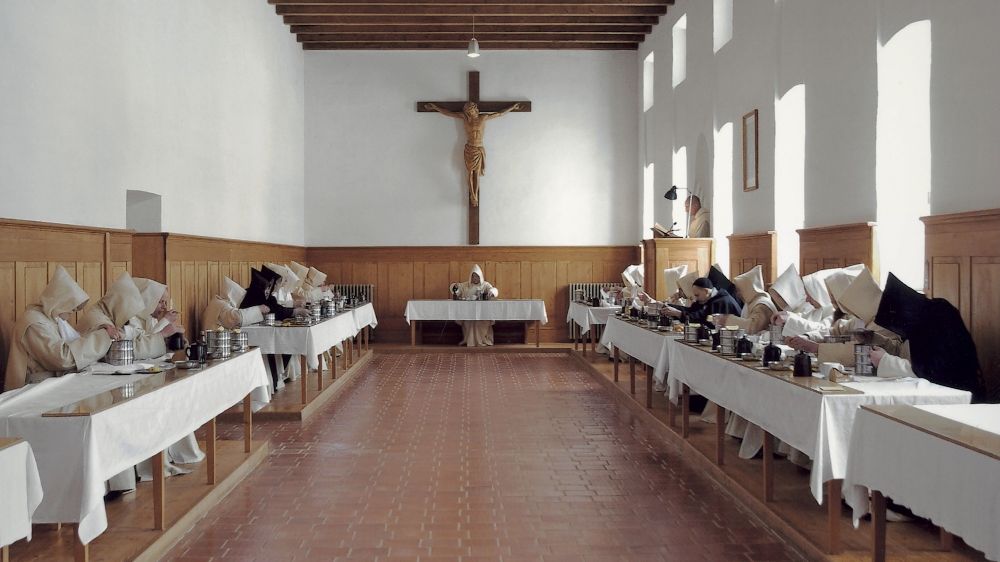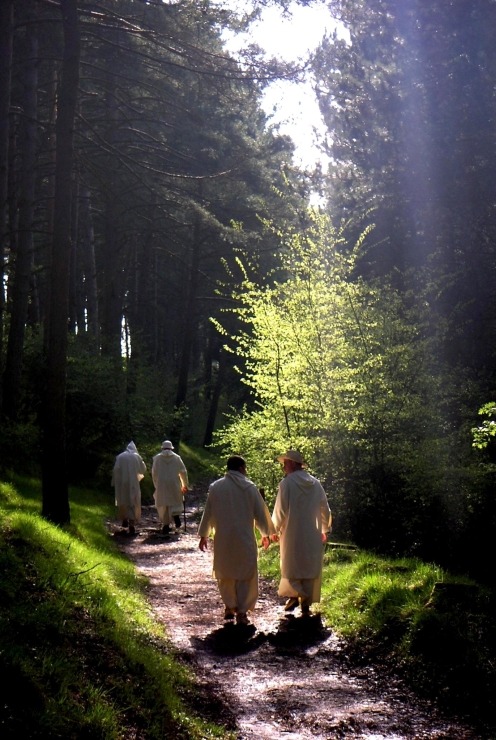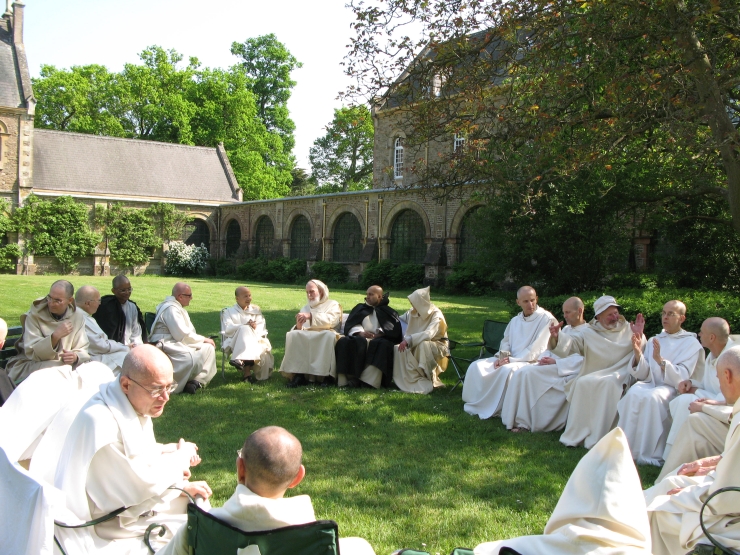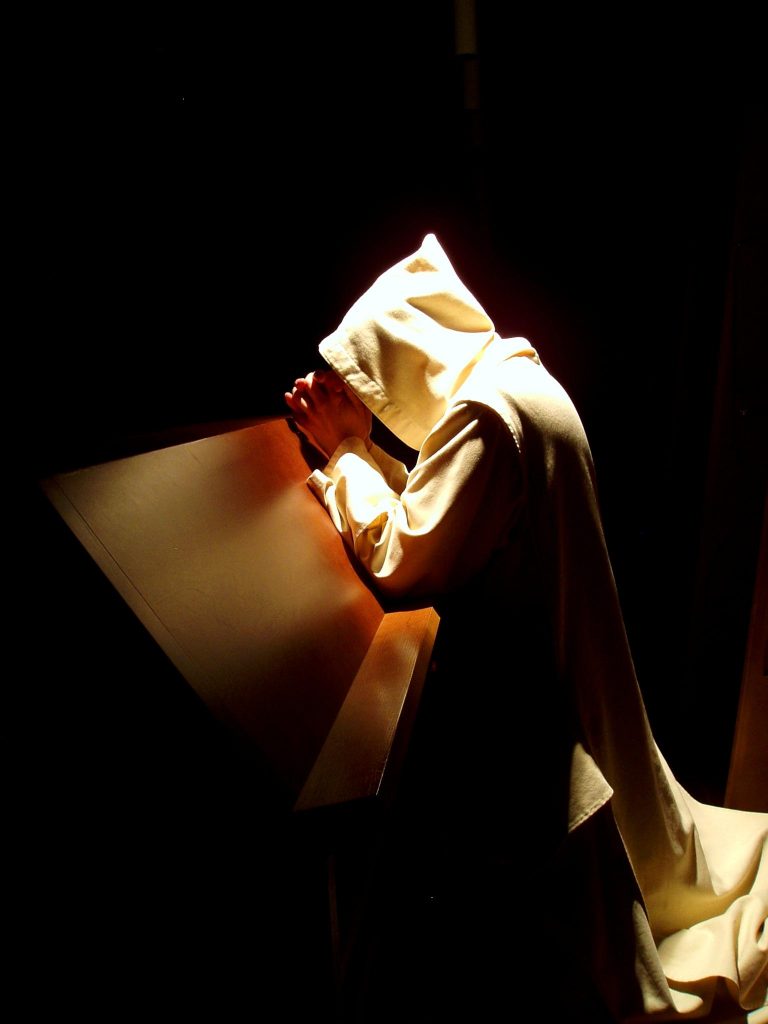« Apart from all, to all we are united, so that it is in the name of all that we stand before the living God. » (Statutes 34.2)
1. The Pourpose
O Bonitas! O Goodness! Such was the cry of joy that sprang from Bruno’s heart, inflamed with divine love. The exclusive goal of the Carthusian way is contemplation: by the power of the Spirit, to live as continually as possible in the light of God’s love for us, manifested in Christ. It means entering into an intimate, deep and continual relationship with God in order to “make us discover the vastness of love” (Statutes 35.1). This presupposes in us purity of heart and charity: “Blessed are the pure in heart, for they shall see God” (Mt 5:8). The monastic tradition also calls this goal pure or continuous prayer.
However, entering into contemplative repose requires a long journey. The monk “cannot enter this rest without going through the trials of a hard struggle, that is, the practice of austerities, as one familiar with the Cross, and the visitations of the Lord, come to prove him as gold in the furnace. Thus, purified by patience, nourished and strengthened by assiduous meditation of Sacred Scripture, and introduced into the depths of his heart by the grace of the Holy Spirit, he will henceforth be able, not only to serve God, but also to cleave to him” (Statutes 3.2).
The whole monastic life, therefore, consists in this journey towards God; all the values of our life are directed towards this goal. They help the monk to unify his life in charity and lead him into the depths of his heart. In fact, it is not this goal that distinguishes us from other contemplative monks (Benedictines, Cistercians…), but the path we take. The essential characteristics of the Carthusian way are: solitude, a part of communal life and an adapted liturgy. It is the spirituality of the desert.
We share certain monastic values with other contemplative monks, for example: ascesis (vigils and fasts), silence, work, poverty, chastity, obedience, listening to the Word of God, regular prayer, humility. Others are specific to us.

2. Solitude
The first essential characteristic of our life is the consecrated solitude, to which we are especially called. The Carthusian monk seeks God in solitude. “Our principal endeavour and our vocation is to devote ourselves to the silence and solitude of the cell. It is holy ground, the place where God and his servant frequently converse, as between friends. There, the faithful soul is often united to the Word of God, the bride with her Spouse, earth is joined to heaven and the human to the divine” (Statutes 4.1). However, the Carthusian has not chosen solitude for its own sake, but because it is for him an excellent means to achieve a greater union with God and with all men. Carthusian solitude is lived on three levels: separation from the world, keeping of the cell, and interior solitude or solitude of the heart.
Separation from the world is achieved by the enclosure. We leave the monastery only for the weekly walk. We do not receive visitors and we do not carry out any apostolate outside. There is no radio or television in the monastery. It is the Prior who receives the news and make known to the monks what they ought to know. Thus are created the necessary conditions that enable interior silence to develop and allow the soul to remain attentive to the presence of God.
The cell is a hermitage set up to ensure that the Carthusian monk a solitude as complete as possible, while providing him with what is necessary for his life. Each cell consists of a two-storey house with a garden, in which the monk remains alone for most of the day for his whole life. It is because of the solitude that each of our charterhouses is called a “desert” or “hermitage”.
The enclosure and the keeping of the cell ensure only an external solitude. This is the first step towards inner solitude, or purity of heart: keeping one’s mind away from everything that is not God or does not lead to God. It is at this level that the Carthusian encounters the vagaries of his imagination and the fluctuations of his sensibility. As long as the monk is arguing with his “self”, his sensitivities, his useless thoughts, his unreal desires, he is not yet centred on God. It is here that he experiences his fragility and the power of the Spirit, and gradually “accustoms himself to a tranquil listening with the heart, which allows God to penetrate it by all ways and all means of access” (Statutes 4.2).

No guests? In the charterhouse the liturgical celebrations do not have a pastoral dimension. This explains why people from outside the Order are not admitted to participate in the offices or the Mass celebrated in the church of our monasteries. Because of our solitary vocation, the visits are limited to the families of the monks (two days a year) and to those aspiring to our life, whom we call retreatants.
3. A Communion of Solitaires
“The grace of the Holy Spirit gathers solitaries together to form a communion in love, as an image of the Church, which is one, though spread throughout the world” (Statutes 21.1). The originality of the charterhouse comes, in the second place, from the part of community life which is indissolubly linked to the solitary aspect. It was the stroke of genius of Saint Bruno, inspired by the Holy Spirit, to combine, from the beginning, solitary life with common life in a right proportion, so as to make the charterhouse a communion of solitaries for God. Solitude and fraternal life balance each other. Common life allows the monastery to function, but it is also an important element in verifying the authenticity of our charity, for otherwise it would be easy for the solitary to live in illusion.
Community life is nourished daily by the liturgy sung in the church, a common work for the glory of God. On ordinary days it takes place three times a day: we gather in church at midnight for the long night service (which includes Matins and Lauds), in the morning for the conventual Mass and in the evening for Vespers.

Sundays and solemnities are more communal days. We say almost all services in church. We take dinner together in the refectory in silence (while listening to a reading). In the afternoon we meet in chapter, where matters of common interest are dealt with. Afterwards the weekly recreation takes place. In addition, on the first free day of the week, there is a long walk of about four hours (“spaciamentum”), during which we can talk freely, which allows us to know each other better and to support each other. Several times a year there is a common recreation, where fathers, brothers and novices meet together.
The purpose of these recreations and walks is to maintain mutual affection and to further fraternal union, while ensuring good physical relaxation.



Frequently asked questions about ordinary life
4. In the Heart of the Church and the World
Praise
It is by entering into the depths of his heart that the solitary Carthusian becomes, in Christ, present to every person. He becomes solitary because he wants to be in solidarity. Contemplatives are at the heart of the Church. They fulfil an essential function of the ecclesial community: the glorification of God. The Carthusian withdraws to the desert above all to worship God, to praise him, to contemplate him, to be conquered by him, to give himself to him in the name of all. It is in the name of all that he is mandated by the Church to lead a life of prayer.
Intercession
The Church has always recognised that monks who are wholly devoted to contemplation fulfil an intercessory role. They represent all humanity and pray daily for the living and the dead in the liturgical offices and the celebration of the Eucharist.
Penance
The ascetic approach associates the Carthusian with the work of Christ, for the salvation of the world: “By penance we take part in Christ’s work of Redemption. He saved the human race, burdened and enslaved by sin, by his prayer to the Father, above all, and by his immolation. In striving to share in this deepest aspect of Redemption and despite our abstention from visible activity, we carry out an apostolate in an outstanding way.” (Statutes 34.4).
Witness
“Being, by our Profession, solely turned towards Him who is, we bear witness, before a world too absorbed by earthly realities, that apart from Him there is no God. Our life shows that the good things from heaven are already present here below; it prefigures the resurrection and anticipates, in a manner, the final renewal of the world.” (Statutes 34.3). For the solitary, bearing such a witness is not achieved through words or personal contact. By his very presence, the monk bears witness that God exists and that he can fill a man’s heart and life.
*
The monk is at the service of all humanity, which he embraces in the depths of his heart when he stands before God. He constantly carries within himself this wounded humanity. He is thus useful, not in the sense that the world gives to this word, but in the resonance of the divine life in man. The Carthusian detaches himself from the things of this world in order to live closer to God, more in the order of being (being for God) than in that of doing. The man living in God and by him carries humanity with him for “every soul that rises above itself, raises up the world” (Venerable Elizabeth Leseur).

